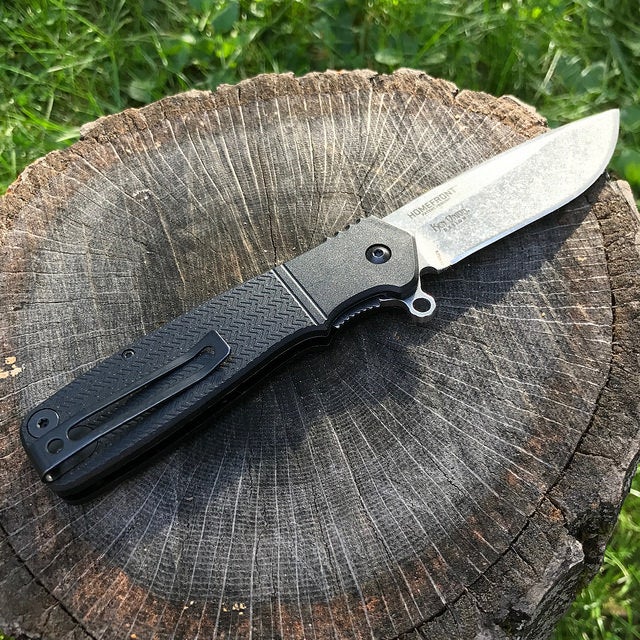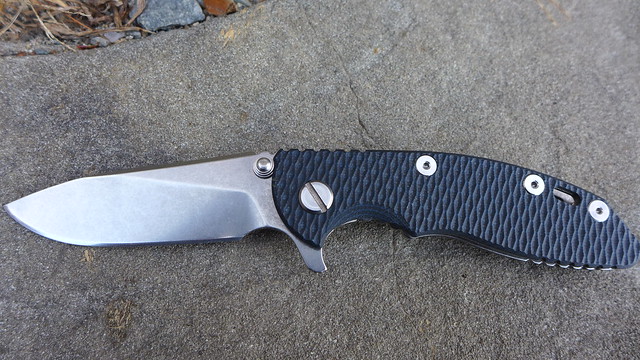The Flipper Tests, Part I
Tony Sculimbrene 03.19.18

If you pulled a Rip Van Winkle and woke up after having been asleep for twenty years you’d probably marvel at smartphones, be stunned at the death of the mall, be surprised at how political ineffectiveness got worse, and be curious about how a Tesla works. If you were a knife fan you’d also be surprised at just how many knives these days are titanium framelock flippers. Twenty years ago these designs were virtually unheard of, now many brands release nothing but titanium framelock flippers. In fact, many of the high end companies operate as if there is nothing but a flipper out there.
The appeal is easy to see—fast, reliable one-hand deployment. But over the years, there have been a lot of different takes on how to make the best flipper. There is a divide between those that like “push button” flippers (flippers that deploy when your index finger pushes the flipper tab down into the handle) and “light switch” flippers (flippers that deploy when your index finger pulls the flipper tab back towards the palm of your hand). Aside from that preference debate there are a whole host of components that go in to making a good flipper. Here is an overview.
The best flippers are marked by five traits: 1) they are comfortable to use; 2) they don’t require extra arm, hand, or wrist movement; 3) they do not fail to fire; 4) they are fast; and 5) the detent works. When reviewing knives, I think of these five traits as the “Flipper Test.” These five traits sound awfully simple, but in reality only a handful of production knives pass this test.
Of course none of this applies to assisted flippers—they fix all of these issues that require craftsmanship and attention to detail with a cheat. Blah cheaters. Assists are also not my favorite because they are loud and attention grabbing when deployed and that spring is just another part that can break. If they offered better performance I would be okay with the cheat, but good unassisted flippers are just as fast and reliable.
Comfort
Look at the shape of the flipper tab, the texture of the “landing strip,” and the closing arc of the flipper tab. Lots of companies think that you need a bit of jimping on the flipper tab so you can get a good purchase on it. This is 100% untrue. A well-design and properly shaped flipper tab can be jimping-free and work well. The Spyderco flipper tab on the Mantra is a good indication of how to properly shape and texture the flipper tab.
The other place you need to check before buying is the spot on the knife where your finger lands after you activate the flipper tab. Jimping here will make the process painful, as does sharp edged liners. Again the Mantra did this well. Finally, some flipper tabs are so long that when you disengage the frame- or linerlock, the tab impacts your thumb. The Brous Silent Solider had this problem and it practically obliterated by thumb nail.
I am in the camp of folks that dislikes “fall shut” flippers, that is knives with pivots so fluid and blade so heavy that they fall closed under their own weight. To me, this serves no purpose and can be dangerous. I have had more than a few “fall shut” flippers take a bit out of me. One last aspect of comfort is how the flipper feels in the pocket. Extra long flipper tabs, what Nick Shabazz calls a pocket pecker, just aren’t comfortable. After days of carry having that flipper tab hit you again and again on the thigh is just no fun. Look for smaller, discrete flipper tabs.
No Extra Movement
Hinderer XM-18s were infamous for needed a bit extra oomph. The languid pivot (made of teflon washers) and the weaker than average detent resulted in a blade that flopped more than flipped. The end result was a blade that needed assistance when being flipped open. Using a stiff wrist flick was all that was needed, but still, a well designed flipper where the pivot and the detent are balanced out, pops open with no assistance whatsoever.
The key to this aspect of a flipper is the balance between the strength of the detent and the fluidity of the pivot. There are three basic ways to make a knife pivot these days—teflon washers, phosphor bronze washers, and bearing pivots. When done well, all three can result in flippers that work.
The teflon washers on the original XM-18s were fine, it was a detent problem. Hinderer remedied this in some of his newer knives like the Half-Track (I don’t know if the Gen 5 XM series knives have fixed it, they were just announced as this article was written). My two Half Tracks both run teflon washers and both were good, though not great flippers. Neither required assistive movements. This is more a problem with the pivot than the detent, but obviously you can tune the detent to cure this issue.
No Failed Fire
Failed fires are when the flipper is correctly activated but the knife fails to deploy. Like the need for assistive action, these knives are not properly balanced between the tension of the detent and the fluidity of the pivot. That said in many cases the knives that fail to fire and the knives that need assistance are different.
In my experience, I have found that a lot of knives that need assistance tend to be big blades, blades that just aren’t fast through the opening arc. Blades that fail to fire, in my experience, are small knives. Think of the difference this way—knives that need an assist are consistently slow and ALWAYS need help. In many cases, fail fire knives pop open fine 90% of the time, but then, inexplicably fail to open that last 10% of the time, usually totally at random.
This is a problem with the detent more than the pivot. The flippers Surefire used to make had this problem. The detent was so weak the blade on my 3 inch model was so light that unless I hit the flipper perfectly it just lopped open. When I perfected the motion, it fired correctly 90% of the time. If the blade were a bit longer or thicker, even a smidge of momentum would be enough to open the knife.
Look for Part II coming soon.


